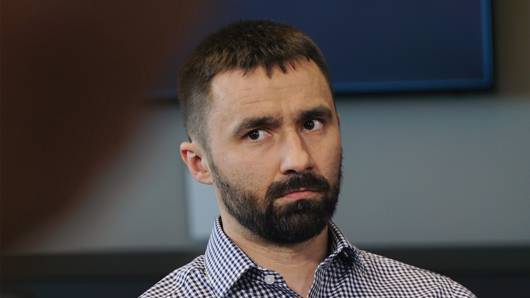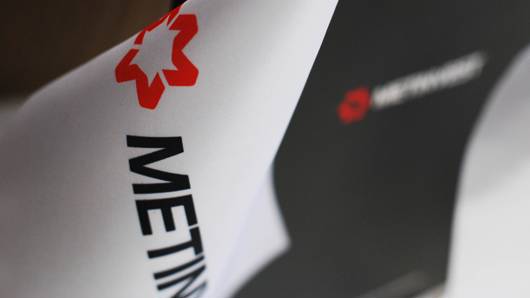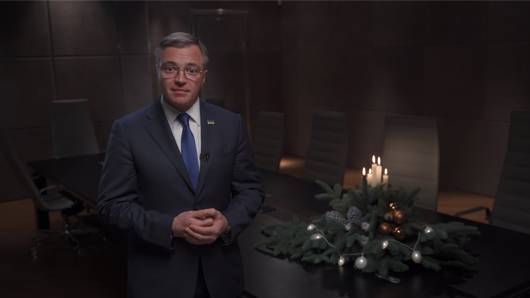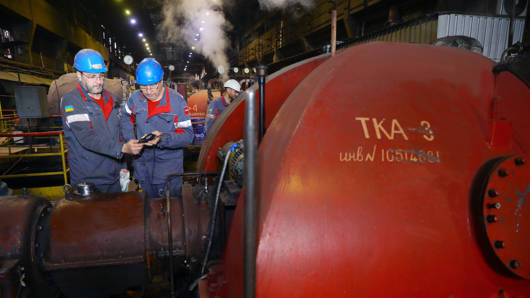In an interview with LIGA.net, Yuriy Ryzhenkov, the CEO of Metinvest, talks about how the Group is adapting to today’s political and military realities, why it is looking at steel plants in Eastern Europe and how it wants to build a network of mini power units around its businesses in Ukraine.
About Mariupol, Azovstal, and doing business during wartime
- The year 2022 was a tragic page in Metinvest's history. The Group lost operational control over its largest plants in Mariupol, Russia blocked Ukrainian seaports, and, as time went on, the country faced power outages. How did this affect the Group's operations?
- The events of 2022 definitely had a serious impact both on Metinvest and Ukraine. I would be lying if I said that it did not affect us. Of course, we considered all scenarios: we trained and we stocked up. Our experience from 2014 to 2017 came in handy here, when Metinvest first lost control over a significant number of facilities and had to reorganise its logistics.
The most terrifying thing for us is not the loss of our facilities, but the loss of our employees. Currently, the confirmed death toll of our employees is over 500. Around 150 of them served in the Armed Forces of Ukraine. Others were innocent civilians, our employees, and their family members. Unfortunately, some of them lost their lives at the workplace, for example, in Avdiivka.
So, yes, 2022 was a very difficult year for the Group. We did not believe until the last moment that Mariupol could be besieged. I didn't believe it, and neither did the military personnel that were communicating with.
- In one of your interviews, you even called it your biggest mistake.
- You know, I always try to look at the situation from a logical point of view, to analyse what is happening not only in politics and economics, but also in society. I never believed that Ukraine would be afraid of a full-scale offensive.
I understood that the forces that the Russians had amassed on our border on 23 February 2022 were not enough to invade the whole of Ukraine.
I thought that there would be people in the Russian General Staff and Russian intelligence who also understood this. Who knew that they would not be welcomed here. Unfortunately, I was wrong when I thought they were smarter.
- Can you recall the conditions under which you evacuated your employees from Mariupol?
- About a week after the city was besieged, we made our first attempt to evacuate people. Together with the municipal authorities, we arranged several buses to evacuate people from the city to an area where at least there was no fighting.
We understood that not all of them could be brought to Ukrainian-controlled territory, but our priority was to bring them at least to Pryazovia, away from the front line. However, the Russians did not allow our buses to leave Mariupol or to enter the city from the direction of Zaporizhzhia.
Volunteers eventually managed to get a certain number of people out of Mariupol. We helped them with this in part by providing money for fuel and cars. Those people were accommodated at our recreation centres on the Azov coast. At that time, the territory was already occupied.
And then we brought those who were willing to Zaporizhzhia, to Kamianske. In total, in cooperation with the Armed Forces of Ukraine, volunteers and regional governors, we evacuated 21,000 people. But this number includes people not only from Mariupol, but also from Avdiivka. Most of them are our employees and their families.
I estimate that there are about 100,000 people left in Mariupol as of now.
- 2021 was the most successful year in Metinvest's history due to market conditions - the Group generated revenues of $18 billion and net profit of $4.8 billion.The results for the first six months of 2022 were worse, but not catastrophic compared to the first half of the previous year. Revenue was $5.3 billion, and EBITDA margin fell from 39% in 2021 to 30% in the first half of 2022. How have you managed to maintain the profitability of the business when Russian missiles are flying over Ukraine?
- First, let's not forget that, in 2022, we had two relatively quiet months – January and February. Back then, we were working at full capacity. And the prices were the best for the steel market. Those first two months allowed us to build up the resilience that we used throughout 2022.
The steel business is cyclical. If you produce something for a month, you sell out your monthly production within three to five months. As such, we would sell everything we produced in January and February on foreign markets for the first half of 2022.
Second, 2021 was the most successful year for us.we had the most successful year of 2021. I would say that the performance of the Group in the first half of 2022 is the result of the full year of 2021 and the first two months of 2022.
- Have you prepared the results of the 12 months of 2022 yet?
- We have, but we cannot disclose this information yet. We will announce the results in a few weeks.
- How have you adapted your businesses to the current political and economic environment?
- Having learned from bitter experience, we had a rough idea of what we needed to do: how to reorganise logistics in the first place. In 2017, Metinvest lost control over seven enterprises in occupied Donbas, including Krasnodon Coal, Yenakiieve Steel, Khartsyzsk Pipe and others.
Those enterprises were integrated into the Group's supply chain. When we lost control over them, we faced a very serious challenge: how to keep our businesses going in Mariupol. The main flow of our iron ore went to Mariupol via Donetsk, even from Kryvyi Rih. When we lost this logistics hub, we had to build our logistics from scratch.
In the first half of 2022, we reorganised our logistics flows to switch to supplying raw materials to other European countries through European ports and railways. At first it was very difficult, but now logistics routes are already well-established.
Economically, it is more profitable to export raw materials through the Black Sea ports. It's not just about loading raw materials and sending them by rail from point A to point B. It means delivering them to the western border of Ukraine, transhipping raw materials onto the European railway gauge, and then carrying them through several European countries or to the port of Constanta in Romania.
- And how much less profitable is it?
For example, if the logistics from Kryvyi Rih to China used to be around US$35-40 per tonne before the full-scale war, now it is around US$125-130 per tonne of raw materials. And this is based on logistics through the most efficient routes – via the Danube and the port of Constanta in the Black Sea.
Nevertheless, we should thank Ukrainian Railways for the help. We often have discussion related to the transportation tariffs, but in this case its approach proved to be quite systematic.
- Metinvest owns four re-rolling plants in the EU and the UK. How has the situation in Ukraine affected your foreign assets?
- They have adjusted to the new environment. As you know, we have four plants in other European countries and a coal mining business in the United States. Now they operate as standalone businesses. Re-rolling plants of the Group outside Ukraine procure semi-finished products by themselves and sell finished goods. The same is true for the mines in the United States. Previously, almost all raw materials from the US went to Ukraine, but now almost everything is sold either to the US or South America or shipped to European markets.
- How has this affected the businesses located in Ukraine?
- We have Kamet Steel and the Zaporizhstal JV, where Metinvest's share is around 50%. We have Avdiivka Coke, Zaporizhia Coke, three iron ore assets, as well as one joint venture.
Avdiivka Coke has been mothballed, Zaporizhstal JV is operating using two blast furnaces out of four, and Kamet Steel is operating two blast furnaces out of three as of January 2023.
In November and December 2022, and in the first days of January 2023, we had problems with electricity supply, but when imported electricity became available, we started buying it from the European Union. As a result, we have managed to increase Kamet Steel's utilisation by 65%.
- How expensive is imported electricity now?
- It is about twice as expensive as on the domestic Ukrainian market. And this is a problem. For a certain period, while we still need to fulfil foreign contracts, we can buy imported electricity. But at some point, this will end. The economic feasibility could simply no longer be viable.
About mobilisation, war damage, and own network of mini-power units
- What challenges do you anticipate in 2023?
- First, it is the continuation of hostilities. The hostilities drain the economy and cause damage to businesses and infrastructure. We saw a few days ago (the interview was recorded on 31 January - Ed.) that Russia has once again attacked our power generation and transmission facilities. And so far, I don't see any prospects for attacks to stop. That is why we are restoring the generation capacity that we have and are looking at what other generation capacity we can buy. Specifically, we are talking about mobile mini-power units.
Second, it is mobilisation. To date, more than 10% of our employees are serving in the Armed Forces of Ukraine. Currently, we are lacking people for the full-scale production in the volumes we can produce. Mobilisation is still ongoing, so this is another challenge for us.
Third, it is the state of the global steel market. So far, there are no problems there, but we can already see that the market is moving in this direction gradually. The year 2021 was the best year for the market in the last 10-15 years. Last year was also a good year for the sector, but there are signs that it is gradually cooling down. This means that market prices for iron ore and metals may fall in the future. This is also a challenge.
- In 2021, Metinvest had almost 87,000 employees. If more than 10% of them are serving in the army, that's almost 8,700 people. How difficult is it today to get employees exempt from mobilisation? Does Metinvest have any problems with this?
- We were able to get some employees exempt. We are one of Ukraine's key strategic enterprises. Even so, we can't get exemptions for all our employees. We understand that our armed forces need soldiers and officers. As such, it is clear that the number of Metinvest employees who are mobilised may increase over time.
A new mechanism for getting employees exempt from mobilisation has already been launched. For our part, we will cooperate with the Ministry of Economy of Ukraine and all other authorities to ensure that, on the one hand, the mobilisation is not disrupted and, on the other hand, that the operations of Metinvest's enterprises is not halted.
- If we compare the Group's losses for 2014-2017 with the losses for 2022. What hit Metinvest harder – the first phase of the war or the second?
- It's hard to compare. The loss of assets is one thing, but the loss of people is quite another. Unlike 2022, the war in the previous years was different. It was a hybrid war. And then, fortunately, people did not die. Today we are losing them and it is a tragedy. Because of this senseless war, we will never be able to bring back 500 employees and their families. For us, the loss of people is a much greater tragedy than the loss of assets.
- Do you know what is happening at your occupied enterprises?
- First, as far as I know, the occupiers tried to re-start Ilyich Steel, but they failed. And I doubt they will pull it off. And second, they have changed their minds several times about what they want to do with Azovstal. The last thing I have heard is that they want to set up a technology park or some kind of resort area on the territory of the Azovstal plant.
I think they have simply found our plans. This was the plan announced by Mayor of Mariupol, Vadym Boychenko before the war. We planned to build several new enterprises outside Mariupol in the next 10-15 years, and to set up either a technology park or a recreation area on Azovstal's site, as it is located in the city centre.
I think other enterprises are also idling, although, even before the full-scale war, I heard that the Yenakiieve plant was operating at about 30% capacity. We even saw pig iron from Yenakiieve Steel and Donetsk Steel on the global market – on the Middle East market. I don’t know what is happening to these enterprises now. The last time I asked about Yenakiieve Steel was before the full-scale war.
- Have you estimated the amount of losses incurred by the Group as a result of the war since 2014?
- Of course. It is tens of billions of US dollars. And we will try to recover them from Russia.
As you know, our shareholder, Rinat Akhmetov, has already said that he will rebuild Mariupol and finance the construction of a new steel production there.
I think that after the liberation, we will build something more environmentally friendly and technologically sophisticated in Mariupol. I do not see any point in restoring Azovstal to its original state.
And this (construction - Ed.) will be funded through reparations.
- You mentioned your plans to buy mini power units. Have you already estimated how many of these units you need to be immune to problems in the power grid?
- We do not have a plan to become fully autonomous. It is very expensive and not economically sound. We want to install generation near our enterprises so that when the power goes out, we can keep production going. To avoid damage to our oxygen units, our blast furnaces, and collecting mains. To prevent a man-made disaster because of a blackout.
We have our own generation: 35 MW at Zaporizhstal JV and 10 MW at Kamet Steel. And we are now looking at 20 MW modular power units and 2.5 MW generator sets. We already have three such generator sets. In particular, Pokrovske Coal has one of them. When the power goes out, we need to lift people from longwalls to the surface and keep ventilation going.
- Are mini power units expensive nowadays?
- It depends. If it is newly built, one megawatt will cost anywhere from €800 thousand to €1 million. Prices depend on the fuel used to generate electricity and on the capacity.
About expansion into Europe, a conversation with Akhmetov, and help to the Armed Forces of Ukraine
- Metinvest outlined its interest to buy the Dunaferr plant in Hungary and build a new steel plant in Italy or Bulgaria. Could this indicate that the Group's business interests are shifting away from Ukraine and towards other countries where you have re-rolling plants rather than iron ore plants?
- We have never hidden the fact that we are interested in other European assets. Metinvest has been looking at European assets throughout its existence, especially in Eastern Europe. That is why we have always looked at US Steel Kosice, Dunaferr, and the Galati plant that has been recently sold by ArcelorMittal. That being said, this is not an alternative to investing in Ukraine's economy, but rather the opposite.
We exported more than half of the iron ore mined in Ukraine, while about one third was consumed in Ukraine. And now that we lost operational control over Azovstal and Illyich Steel, this figure is even lower. As such, in order to develop our businesses here, we need to find a regular customer. The plant in Bulgaria or Italy will also use our high-grade Ukrainian pellets.
Moreover, we have plans to develop both Kamet Steel and Zaporizhstal JV. And when we de-occupy Mariupol, there will be investment plans there as well. The only thing is that Ukraine must win. Win and get serious guarantees that there will be no new war. Not a new Budapest Memorandum, but real guarantees. And only then will investors come here. We already had the Minsk 1 and Minsk 2 agreements. We believed in them. Since 2014, we have invested billions in Azovstal and Illyich Steel. And what did we get in return? Ruins.
- Recently, the first privatisation of the Ust-Dunaisk seaport has taken place in Ukraine. If the government continues to put commercial ports up for privatisation in the future, would you be interested in participating? As far as I know, Metinvest was once interested in the Pivdennyi seaport.
- The port that has been privatised is almost a river port. It is not suitable for our products. If we are going to consider buying ports, they should be large – able to handle vessels of 20,000 - 40,000 tonnes, or 120,000 - 180,000 tonnes, Panamax and Capesize vessels.
In Ukraine, there is only one port that can accommodate vessels capable of carrying 180,000 tonnes – the Pivdennyi port. As such, we may be interested in this, but these have to be ports that can accommodate large vessels. Small ports are not suitable for the steel industry.
- Apart from the Pivdennyi port, are there any other ports in Ukraine that can handle such large vessels?
- Yes. The port of Mariupol, Berdiansk, and there is also the Chernomorsk commercial seaport.
And by the way, it is not necessary to put the entire port up for privatisation. One can privatise a pier and build a terminal there. Ports can be privatised in parts, but in this scenario, it is necessary to ensure that the management of water transportation is transparent.
- Before the war, Metinvest had plans afoot for the construction of own university in Mariupol. It is clear that the war changed the plans, so this university is now online. Are you considering building a similar university in another location – in Kyiv, Kryvyi Rih, or Zaporizhzhia?
- We are currently working online, but in the future, we want to build it in de-occupied Mariupol. Are we considering other locations, for example, in Zaporizhzhia? Yes, we are considering it, but Zaporizhzhia is also close to the front line now. The city is less than 40 kilometres from the front line.
The main idea of this university is that it should be as close to production as possible, so that students have the opportunity to put theory into practice. The cost of the project we wanted to build in Mariupol was estimated at €30 million. It was a project of the future – a university made of steel with the latest energy-saving technologies with its own laboratories, a sports complex, and a modern dormitory. It was supposed to be a hub for 1,000-1,200 students.
I think we will definitely build it in the future. But in a de-occupied Mariupol.
- Recently, the president has enacted the NSDC sanctions against Vadym Novynskyi, a minority shareholder of Metinvest. Do you know how Rinat Akhmetov, the Group's majority shareholder, has reacted to this?
- We have a delimitation between the Group's management and shareholders. There is a Supervisory Board. So, I do not know about the shareholder's attitude to the NSDC decision. To be honest, I didn't ask.
We will see how the events unfold. From the Group's perspective, this has not affected our work in any way.
We have discussed this decision with our international partners. They understand that this has nothing to do with the company. Metinvest operates in full compliance with the Ukrainian and international legal frameworks and fulfils its obligations to the state. Moreover, we are actively helping it in the war against Russia.
- Even before the war, it seemed that Rinat Akhmetov paid more attention to his football business than to Metinvest or DTEK. And how is it now? Do you have a feeling that the shareholder is now paying more attention to you?
But, of course, he, like any shareholder, wants to know what is happening with his business, so we communicate on a regular basis. As a shareholder, he gives us certain signals and shares his vision. The journalists of The Telegraph recently asked me how the shareholder reacted to Russia's full-scale invasion. And I retold them the conversation.
- Do what you want, but Ukraine must win this war, and the company must do everything to make it happen.
That's the message he gave me, and Metinvest started working, buying thermal imagers for the Armed Forces of Ukraine, manufacturing bulletproof vests and mobile shelters, and shipping cars, drones, and fuel to the front lines. I think the management of DTEK received exactly the same signal.
- How did the company come up with the idea to make bulletproof vests and underground dugout capsules?
- It's an interesting story. Since Soviet times, we have had drawings on how to fabricate these shelters. In Soviet times, every enterprise had to produce something for the army. It's funny, but tractor factories, for example, used to build tanks as their main product, and tractors were a by-product.
When the full-scale invasion began, we dug into the archives. We started looking for ways we could help. We found drawings of armoured steel bunkers. There are several types of them. For example, there are bunkers for sleeping. There are bunkers that can be used as bathhouses and canteens. And there are bunkers for storing documentation. The military is satisfied with these capsules.
We also developed our armoured steel technology back in March and April. We got it certified and started to produce it. All the armour plates we produce are fired at and tested. We order plate carriers and then ship finished vests to our military.
These figures change almost every day, but in the first 11 months of last year we have already delivered more than 100 capsules, 25,000 helmets, and 150,000 bulletproof vests to the army. Every tenth member of the Armed Forces of Ukraine, the National Police and the State Emergency Service now wears bulletproof vests from Metinvest.
We either made them ourselves or bought them and donated them.
- It has recently become known that Metinvest does not own the Azovstal trademark. That the trademark in question belongs to cyber-swatter Oleg Bogatov. Back in the day, Metinvest bought several trademarks from him. What are your plans in this regard now?
- Before the beginning of the full-scale war, it was not a priority for us to use the Azovstal trademark. We operated as a single group. Why is this important for us now? Because this trademark is being abused. Various people have started using it.
We have filed a patent for the Azovstal trademark. We will see what happens next. It's not critical for us. We just want to protect the Azovstal trademark from misuse.










